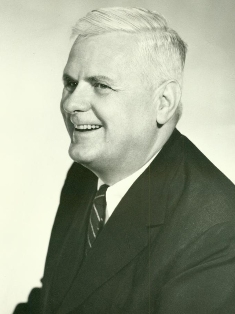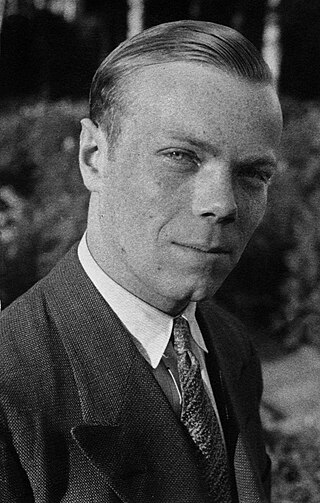Automated theorem proving is a subfield of automated reasoning and mathematical logic dealing with proving mathematical theorems by computer programs. Automated reasoning over mathematical proof was a major impetus for the development of computer science.
First-order logic—also known as predicate logic, quantificational logic, and first-order predicate calculus—is a collection of formal systems used in mathematics, philosophy, linguistics, and computer science. First-order logic uses quantified variables over non-logical objects, and allows the use of sentences that contain variables, so that rather than propositions such as "Socrates is a man", one can have expressions in the form "there exists x such that x is Socrates and x is a man", where "there exists" is a quantifier, while x is a variable. This distinguishes it from propositional logic, which does not use quantifiers or relations; in this sense, propositional logic is the foundation of first-order logic.
Mathematical logic is the study of formal logic within mathematics. Major subareas include model theory, proof theory, set theory, and recursion theory. Research in mathematical logic commonly addresses the mathematical properties of formal systems of logic such as their expressive or deductive power. However, it can also include uses of logic to characterize correct mathematical reasoning or to establish foundations of mathematics.

In mathematics, a theorem is a statement that has been proved, or can be proved. The proof of a theorem is a logical argument that uses the inference rules of a deductive system to establish that the theorem is a logical consequence of the axioms and previously proved theorems.

Alonzo Church was an American mathematician, computer scientist, logician, and philosopher who made major contributions to mathematical logic and the foundations of theoretical computer science. He is best known for the lambda calculus, the Church–Turing thesis, proving the unsolvability of the Entscheidungsproblem, the Frege–Church ontology, and the Church–Rosser theorem. Alongside his doctoral student Alan Turing, Church is considered one of the founders of computer science.

A mathematical proof is a deductive argument for a mathematical statement, showing that the stated assumptions logically guarantee the conclusion. The argument may use other previously established statements, such as theorems; but every proof can, in principle, be constructed using only certain basic or original assumptions known as axioms, along with the accepted rules of inference. Proofs are examples of exhaustive deductive reasoning which establish logical certainty, to be distinguished from empirical arguments or non-exhaustive inductive reasoning which establish "reasonable expectation". Presenting many cases in which the statement holds is not enough for a proof, which must demonstrate that the statement is true in all possible cases. A proposition that has not been proved but is believed to be true is known as a conjecture, or a hypothesis if frequently used as an assumption for further mathematical work.

Jacques Herbrand was a French mathematician. Although he died at age 23, he was already considered one of "the greatest mathematicians of the younger generation" by his professors Helmut Hasse and Richard Courant.
HOL denotes a family of interactive theorem proving systems using similar (higher-order) logics and implementation strategies. Systems in this family follow the LCF approach as they are implemented as a library which defines an abstract data type of proven theorems such that new objects of this type can only be created using the functions in the library which correspond to inference rules in higher-order logic. As long as these functions are correctly implemented, all theorems proven in the system must be valid. As such, a large system can be built on top of a small trusted kernel.
Proof theory is a major branch of mathematical logic and theoretical computer science within which proofs are treated as formal mathematical objects, facilitating their analysis by mathematical techniques. Proofs are typically presented as inductively-defined data structures such as lists, boxed lists, or trees, which are constructed according to the axioms and rules of inference of a given logical system. Consequently, proof theory is syntactic in nature, in contrast to model theory, which is semantic in nature.

Metamathematics is the study of mathematics itself using mathematical methods. This study produces metatheories, which are mathematical theories about other mathematical theories. Emphasis on metamathematics owes itself to David Hilbert's attempt to secure the foundations of mathematics in the early part of the 20th century. Metamathematics provides "a rigorous mathematical technique for investigating a great variety of foundation problems for mathematics and logic". An important feature of metamathematics is its emphasis on differentiating between reasoning from inside a system and from outside a system. An informal illustration of this is categorizing the proposition "2+2=4" as belonging to mathematics while categorizing the proposition "'2+2=4' is valid" as belonging to metamathematics.
In mathematics and logic, the term "uniqueness" refers to the property of being the one and only object satisfying a certain condition. This sort of quantification is known as uniqueness quantification or unique existential quantification, and is often denoted with the symbols "∃!" or "∃=1". For example, the formal statement
John Barkley Rosser Sr. was an American logician, a student of Alonzo Church, and known for his part in the Church–Rosser theorem in lambda calculus. He also developed what is now called the "Rosser sieve" in number theory. He was part of the mathematics department at Cornell University from 1936 to 1963, chairing it several times. He was later director of the Army Mathematics Research Center at the University of Wisconsin–Madison and the first director of the Communications Research Division of IDA. Rosser also authored mathematical textbooks.

In computer science and mathematical logic, a proof assistant or interactive theorem prover is a software tool to assist with the development of formal proofs by human-machine collaboration. This involves some sort of interactive proof editor, or other interface, with which a human can guide the search for proofs, the details of which are stored in, and some steps provided by, a computer.
In logic and theoretical computer science, and specifically proof theory and computational complexity theory, proof complexity is the field aiming to understand and analyse the computational resources that are required to prove or refute statements. Research in proof complexity is predominantly concerned with proving proof-length lower and upper bounds in various propositional proof systems. For example, among the major challenges of proof complexity is showing that the Frege system, the usual propositional calculus, does not admit polynomial-size proofs of all tautologies. Here the size of the proof is simply the number of symbols in it, and a proof is said to be of polynomial size if it is polynomial in the size of the tautology it proves.
In computer science, in particular in knowledge representation and reasoning and metalogic, the area of automated reasoning is dedicated to understanding different aspects of reasoning. The study of automated reasoning helps produce computer programs that allow computers to reason completely, or nearly completely, automatically. Although automated reasoning is considered a sub-field of artificial intelligence, it also has connections with theoretical computer science and philosophy.

Burton Spencer Dreben was an American philosopher specializing in mathematical logic. A Harvard graduate who taught at his alma mater for most of his career, he published little but was a teacher and a critic of the work of his colleagues.
The history of the Church–Turing thesis ("thesis") involves the history of the development of the study of the nature of functions whose values are effectively calculable; or, in more modern terms, functions whose values are algorithmically computable. It is an important topic in modern mathematical theory and computer science, particularly associated with the work of Alonzo Church and Alan Turing.
Q0 is Peter Andrews' formulation of the simply-typed lambda calculus, and provides a foundation for mathematics comparable to first-order logic plus set theory. It is a form of higher-order logic and closely related to the logics of the HOL theorem prover family.







